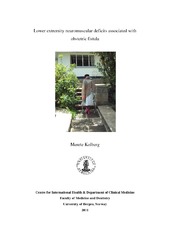Lower extremity neuromuscular deficits associated with obstetric fistula
Master thesis
Permanent lenke
https://hdl.handle.net/1956/21634Utgivelsesdato
2011Metadata
Vis full innførselSamlinger
Sammendrag
SUMMARY Background: Obstetric fistula affects thousands of women every year, one of the dreadful consequences of surviving an obstructed labour. A majority of these are left untreated, abandoned by their husband and family to a life in increasing poverty and misery. Not only do these women suffer from leakage of urine and faeces, many also end up with additional tragic complications of the obstructed labour, one of them being lower extremity neuromuscular deficits. Several studies report on drop foot and walking difficulties in patients with obstetric fistula. However, less obvious neuromuscular sequel has not been focused. Assuming that such deficits exist we aimed to describe the neuromuscular function hip down in women with obstetric fistula to uncover such deficits. Methods: This hospital-based case-control study was carried out at University of Gondar, Ethiopia. According to a power-calculation 101 cases of obstetric fistula and a corresponding number of controls were planned. Participants were included and a short questionnaire was used to collect background data, and the following measurements were carried out: height, weight, passive range of motion of lower extremities (PROM), manual muscle testing of lower extremities (MMT), testing of reflexes, and ankle, leg and upper arm circumference. The measurements were taken by one of two physiotherapists. Results: During the allocated study period 51 cases and 100 controls had been included in the study. Women with obstetric fistula were significantly shorter than the controls (150.8 cm vs. 156.7 cm), had a lower weight (44.5 kg vs. 48.7 kg), were of similar BMI (19), had had a longer duration of labour (2.8 vs. 0.5 days) and a generally high rate of stillbirth. Leg pain and walking difficulties immediately following the delivery were significantly more commonly reported in the fistula group (19.6 vs. 7 % and 33.3 vs. 0 %, respectively). As many as 27 % of the fistula cases still complained of walking difficulties at the time of the present hospital admission, but it did not seem to affect activities of daily life to a great extent when compared with the control group (19 %). Time since delivery was not significantly different in the groups (median 3 years for fistula patients and 4 years for controls). No joint contracture was found, but decreased passive range of motion on knee flexion and extension, and ankle dorsal and plantar flexion was seen. 2 cases also had their passive dorsal flexion completely lost, one of them in both ankles. A marginally increased passive range of motion on hip extension and hip abduction was also found. The fistula cases were stronger for hip extension, knee flexion and hip lateral rotation. No drop foot was found, but a tendency towards decreased strength of ankle dorsal flexion and inversion. There was no difference in testing reflexes, and only marginally smaller upper arm circumference. Controlling for observer did not seem to affect the results. Conclusion: Women with obstetric fistula more commonly report of pain and walking difficulties in the time following the obstructed labour. With years passing by much of these problems seems to resolve but at examination at median 3 years after birth some signs of less obvious impairment and compensatory adaptation may be traced. The results, however suffer from a yet not completed recruitment of participants.
